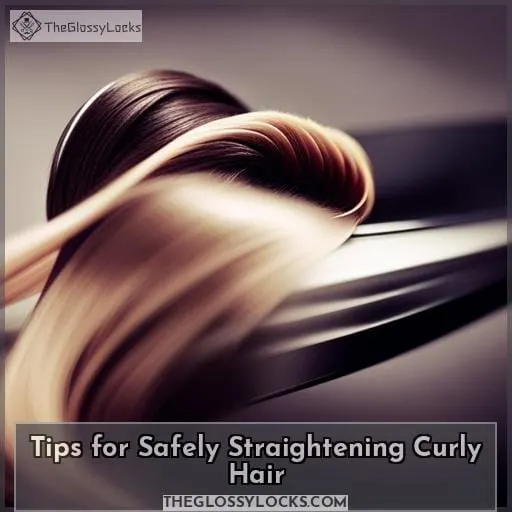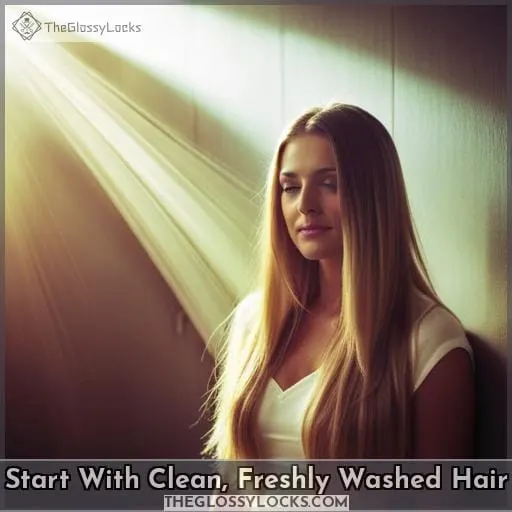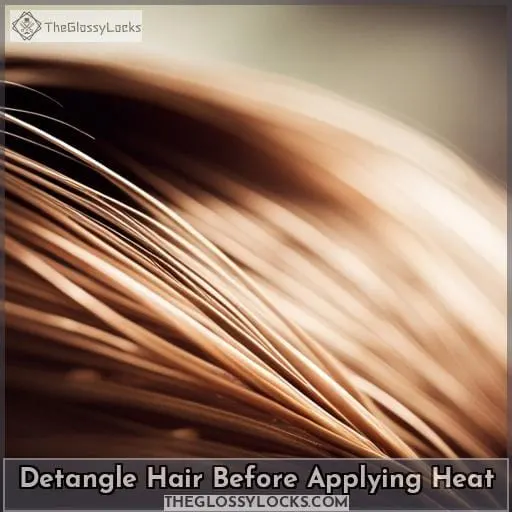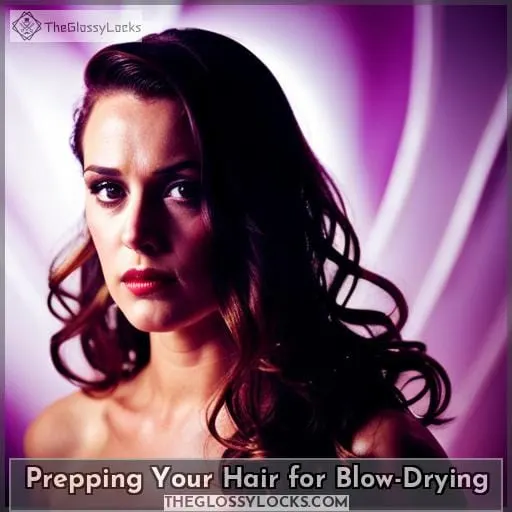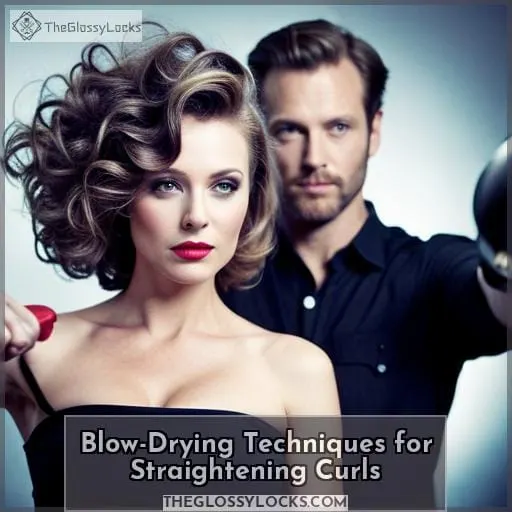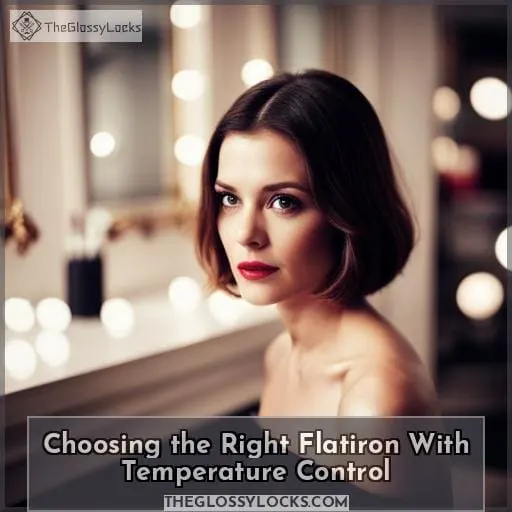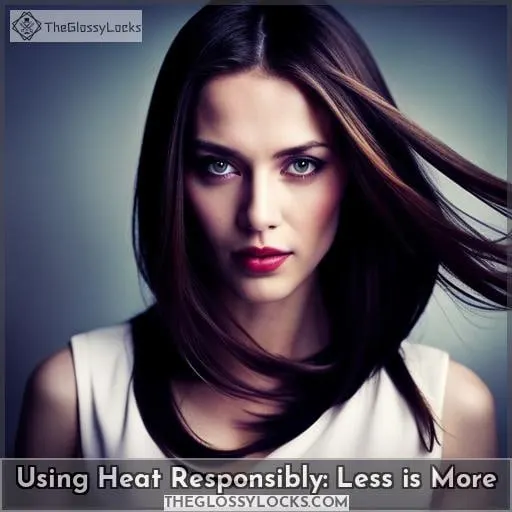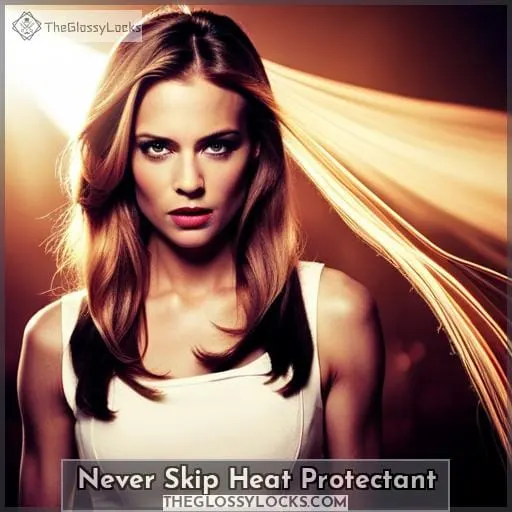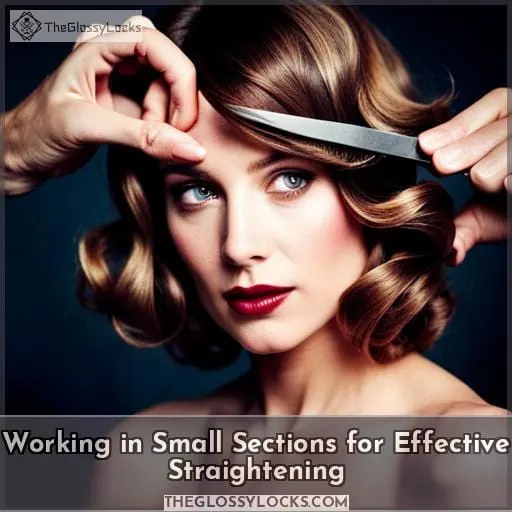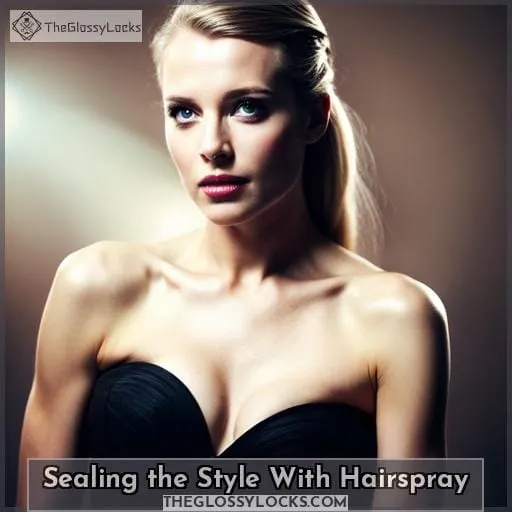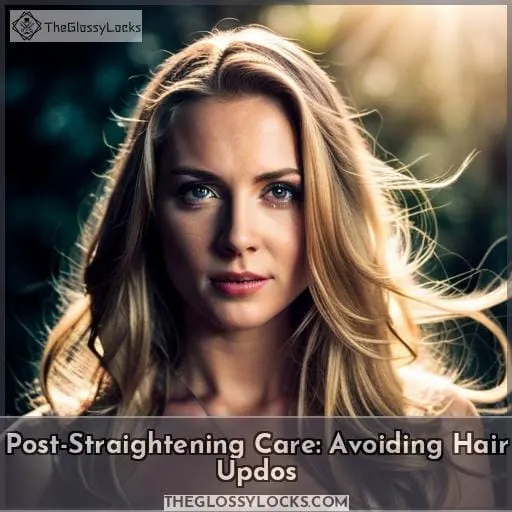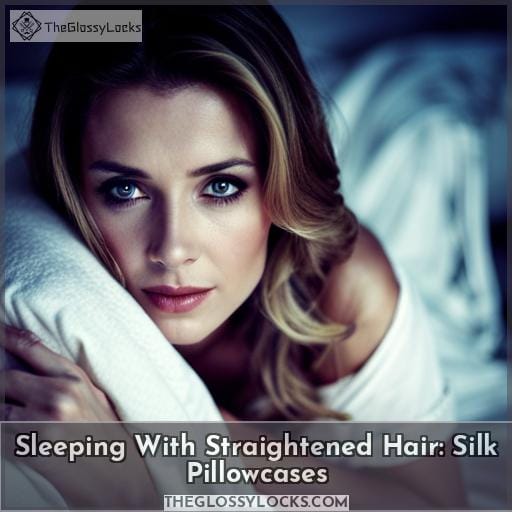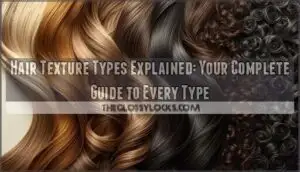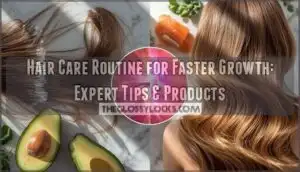This site is supported by our readers. We may earn a commission, at no cost to you, if you purchase through links.
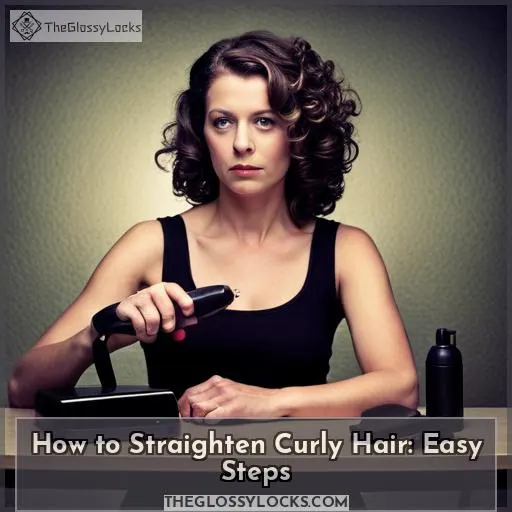 Ready to unleash your inner hair stylist? Learn how to straighten curly hair with these easy steps.
Ready to unleash your inner hair stylist? Learn how to straighten curly hair with these easy steps.
From understanding different curl patterns to prepping your locks for blow-drying, we’ve got you covered.
Discover the importance of temperature control and working in small sections when using a flatiron, as well as the benefits of using heat protectant.
Say goodbye to frizz and hello to sleek, straight strands that will have heads turning everywhere you go!
Table Of Contents
- Key Takeaways
- Tips for Safely Straightening Curly Hair
- Understanding Different Curl Patterns
- Start With Clean, Freshly Washed Hair
- Detangle Hair Before Applying Heat
- Prepping Your Hair for Blow-Drying
- Blow-Drying Techniques for Straightening Curls
- Choosing the Right Flatiron With Temperature Control
- Using Heat Responsibly: Less is More
- Never Skip Heat Protectant
- Working in Small Sections for Effective Straightening
- Sealing the Style With Hairspray
- Post-Straightening Care: Avoiding Hair Updos
- Sleeping With Straightened Hair: Silk Pillowcases
- Frequently Asked Questions (FAQs)
- What are some common ingredients to look for in products for straightening curly hair?
- How often should you touch up your straightened hair?
- What are some alternative methods for straightening curly hair without using heat?
- Can you straighten your hair if it’s wet?
- How long does it typically take to straighten curly hair?
- Conclusion
Key Takeaways
- Use heat protectant and low heat settings to safely straighten curly hair.
- Work in small sections and avoid hair updos to achieve a smooth finish.
- Use silk pillowcases to protect straightened hair while sleeping.
- Choose the right flatiron with temperature control and regularly apply heat protectant for responsible heat usage.
Tips for Safely Straightening Curly Hair
To safely straighten your curly hair, you should follow these tips:
First and foremost, it’s important to avoid heat damage by using a heat protectant before applying any heat to your hair.
Additionally, using a low heat setting on your flat iron or hair straightener can help minimize the risk of causing damage to your locks.
Working in small sections is another key tip as it allows for more control and ensures that each section is adequately straightened without excessive exposure to high temperatures.
Finally, consider sleeping on a silk pillowcase as it reduces friction against the hair while you sleep, helping preserve the straightened style for longer periods of time.
Understanding Different Curl Patterns
Understanding the different curl patterns is essential for effectively straightening curly hair.
Each person has a unique curl pattern, which can range from loose waves to tight coils.
To determine your specific curl pattern, you can refer to a curl pattern chart or hair texture chart that categorizes curls into various types, such as Type 2 (wavy), Type 3 (curly), and Type 4 (coily).
Additionally, factors like porosity and hair strand thickness also play a role in understanding your hair’s needs when it comes to styling and straightening.
By knowing the characteristics of your curls, you can choose appropriate products and techniques that will help achieve desired results while minimizing damage.
Start With Clean, Freshly Washed Hair
Now that you understand the different curl patterns, it’s time to dive into the first step of straightening curly hair: starting with clean, freshly washed hair. This is crucial as it sets a solid foundation for achieving sleek and smooth results.
- Use lukewarm water: Rinse your hair with lukewarm water instead of hot water, as hot water can strip away natural oils and cause frizz.
- Apply leave-in conditioner: After washing your hair, apply a leave-in conditioner to keep it hydrated and protected during the straightening process.
- Work in small sections: Sectioning off your damp or towel-dried hair will make styling easier and more manageable.
- Use a wide tooth comb: Before blow-drying, gently detangle each section using a wide tooth comb to prevent breakage.
By following these steps, you’ll create an optimal environment for effective heat styling without causing unnecessary damage or frizz.
Detangle Hair Before Applying Heat
Before applying heat, detangle your hair using a wide tooth comb. This step is crucial to avoid heat damage and ensure that the straightening process goes smoothly.
Working in small sections allows you to thoroughly detangle each strand, preventing any knots or tangles from getting caught in the flat iron.
Starting with clean hair provides a fresh canvas for straightening and helps to achieve better results.
Additionally, it’s important to apply a heat protectant before subjecting your hair to high temperatures. This will create a barrier between your strands and the heat of styling tools, reducing the risk of damage and promoting healthier-looking locks.
| Steps | Tips |
|---|---|
| Use wide tooth comb | Wide teeth are gentler on curly hair than fine-toothed combs |
| Work in small sections | Smaller sections allow for more control when detangling |
| Start with clean hair | Cleanse your scalp well before starting so that there’s no product build-up |
Prepping Your Hair for Blow-Drying
To prep your hair for blow-drying, start by:
- Applying a heat protectant.
- Detangling with a wide tooth comb.
Before blow-drying, it’s important to use lukewarm water when rinsing your hair to avoid stripping away natural oils.
After washing, apply a leave-in conditioner to provide extra moisture and protection from heat damage.
Working in small sections will ensure that each part of your hair receives equal attention during the blow-drying process.
When blowing dry your hair up towards the roots, you create volume at the base which helps in achieving straighter locks later on.
Lastly, don’t forget to use a heat protectant spray before using any hot tools on your hair as this will help shield it from high temperatures and minimize damage caused by styling.
Blow-Drying Techniques for Straightening Curls
To effectively straighten your curly hair, you should regularly blow-dry your hair in small sections. This technique helps to ensure that each strand gets the attention it needs for a smooth and sleek finish.
Here are three blow-drying techniques that can help you achieve straighter locks:
- Use a diffuser attachment:
- Attach a diffuser to your blow dryer to distribute heat evenly and minimize frizz.
- Place small sections of damp hair onto the diffuser, gently scrunching upwards towards the roots as you dry.
- Round brush method:
- Take a round brush and hold a section of hair taut with tension while directing airflow from the dryer downward along its length until it’s completely dry.
- Low heat with cool shot:
- Set your blow dryer on low heat setting while using moderate air flow for less damage to fragile curly strands.
- Finish off by switching to cool shot mode which helps seal in shine and set style.
Choosing the Right Flatiron With Temperature Control
When straightening curly hair, it’s important to choose a flatiron with temperature control. This allows you to adjust the heat setting based on your hair type and condition, minimizing damage.
Working in small sections also helps ensure that each strand receives even heat distribution for smoother results.
Additionally, using a heat protectant spray before straightening can provide an extra layer of protection against heat damage.
Importance of temperature control
To ensure safe and effective straightening of curly hair, it’s crucial to understand the importance of temperature control when choosing the right flatiron.
Heat damage can severely impact hair health, so selecting a flat iron with adjustable heat settings that cater to your specific hair type is essential for minimizing potential damage.
Benefits of working in small sections
When choosing the right flatiron with temperature control, it’s important to work in small sections for optimal results.
Working in small sections:
-Prevents heat damage
-Reduces frizz
-Creates a smooth finish
-Prevents breakage
-Helps your hair hold its style
Using heat protectant effectively
Before straightening your curly hair, choose a flatiron with temperature control to effectively use heat protectant.
Heat protectants are essential for protecting colored, dry, damaged, and frizzy hair from heat damage. They provide a barrier between your strands and the high temperatures of styling tools like flat irons.
Using Heat Responsibly: Less is More
Now that you have chosen a flatiron with temperature control, it’s time to learn how to use heat responsibly.
When it comes to straightening curly hair, less is more. Using high heat can lead to significant damage and breakage, so it’s important to exercise caution and patience during the process.
Start by setting your flatiron on a low heat setting instead of cranking up the temperature. This will help minimize the risk of damaging your hair while still achieving smooth results.
Be prepared for some trial and error as you find what works best for your unique curl pattern. It may take some time and experimentation before you master using low heat effectively without sacrificing the desired sleekness in your locks.
By using low heat responsibly and practicing proper technique with patience, you can achieve beautifully straightened curls without compromising their health or vitality.
Never Skip Heat Protectant
First, never skip applying a heat protectant to your hair before using any hot styling tools.
Here are some essential tips to keep in mind when it comes to heat protectants:
- Choose the right heat protectant: Look for products that specifically mention heat protection on the label. There are various brands available in the market, such as TRESemmé Thermal Creations Heat Tamer Spray and Garnier Fructis Sleek & Shine Flat Iron Perfector Straightening Mist.
- Check the ingredients: Opt for a heat protectant that contains ingredients like silicones or polymers, which create a barrier between your hair and the high temperatures of styling tools.
- Apply evenly: Make sure to distribute the product evenly throughout your hair before using any hot tool.
- Use regularly: Incorporate using a heat protectant into your regular hairstyling routine – not just when straightening – as this will help maintain healthy and protected locks.
Working in Small Sections for Effective Straightening
To achieve effective straightening, work in small sections of your hair. This method allows for better control and ensures that every strand is properly straightened.
By dividing your hair into smaller portions, you can focus on each section individually and avoid heat damage caused by excessive exposure to high temperatures.
Before starting the straightening process, make sure your hair is clean and free from any tangles or knots.
Additionally, using a flatiron with temperature control is essential to adjust the heat according to your specific needs without causing unnecessary damage to your hair strands.
Remember to always use a heat protectant before applying any direct heat onto your locks for added protection against thermal damage.
Sealing the Style With Hairspray
To seal the style and ensure long-lasting results, you should spray a light mist of hairspray over your straightened hair.
Hairspray not only holds your style in place but also protects your hair from humidity and frizz throughout the day.
When choosing a hairspray, opt for one that provides a strong hold without making your hair feel crunchy or stiff.
To apply the hairspray, hold the can about 12 inches away from your head and lightly mist it over your entire hairstyle. Be sure to use just enough product to maintain control without weighing down or causing buildup on your strands.
The amount of time that the hairspray will hold varies depending on different factors such as weather conditions and individual hair type; however, most high-quality sprays should keep your style intact for several hours.
Post-Straightening Care: Avoiding Hair Updos
Avoid putting your hair up immediately after straightening it.
While it may be tempting to throw your newly straightened locks into a sleek ponytail or bun, doing so can ruin all your hard work. The heat from the styling tools will cause the hair to become malleable and susceptible to losing its shape when secured in an updo.
Instead, let your hair air dry completely before attempting any hairstyles that involve pulling or wrapping the hair tightly.
If you need to touch up certain areas of your straightened hair throughout the day, opt for using dry shampoo instead of resorting to tying it back or securing it with clips and pins. This way, you can maintain the smoothness and shine without compromising on style longevity.
Sleeping With Straightened Hair: Silk Pillowcases
You should always consider using silk pillowcases when sleeping with straightened hair to minimize friction and maintain your sleek style.
Silk is a smooth, gentle fabric that helps avoid frizz, reduce damage, protect hair from tangles, and prolong the longevity of your straightened style.
Unlike cotton or other materials that can cause friction and create unwanted texture in your hair overnight, silk allows for smoother movement against the pillowcase.
The result? Less frizz and fewer tangles in the morning!
By investing in a silk pillowcase, you’re taking an extra step towards keeping your straightened hair looking fabulous for longer periods of time while protecting it from unnecessary damage caused by rough surfaces during sleep.
Frequently Asked Questions (FAQs)
What are some common ingredients to look for in products for straightening curly hair?
When looking for products to straighten curly hair, common ingredients to consider include:
- Coconut oil
- Castor oil
- Soybean oil
- Almond oil
- Aloe vera extract
- Milk protein extracts
- Honey
- Apple cider vinegar.
These ingredients provide moisture and nourishment while helping to smooth and tame the curls.
How often should you touch up your straightened hair?
To maintain your straightened hair, touch up every few days to keep it sleek and smooth. This ensures a long-lasting style that exudes confidence and control over your stunning locks.
What are some alternative methods for straightening curly hair without using heat?
To straighten curly hair without using heat, consider alternative methods such as:
- Wet setting with rollers or braids
- Using a silk wrap overnight
- Trying chemical relaxers
Experiment to find the method that works best for your hair type and desired results.
Can you straighten your hair if it’s wet?
Straightening wet hair isn’t recommended as it can cause damage.
It’s best to wait until your hair is completely dry before using heat styling tools like a flat iron.
How long does it typically take to straighten curly hair?
On average, it takes about 30 minutes to an hour to straighten curly hair, depending on the length and thickness of your hair.
Remember to work in small sections and use a low heat setting for best results.
Conclusion
To unleash your inner hair stylist and achieve sleek, straight strands, follow these easy steps to straighten your curly hair.
Start by understanding your curl pattern and prepping your locks for blow-drying.
Choose a flatiron with temperature control and work in small sections for effective results.
Don’t forget to use heat protectant and remember that less is more when it comes to using heat.
Seal your style with hairspray and avoid hair updos to maintain your straightened look.
Sleep on silk pillowcases for added protection.
Say goodbye to frizz and hello to beautifully straight hair!

